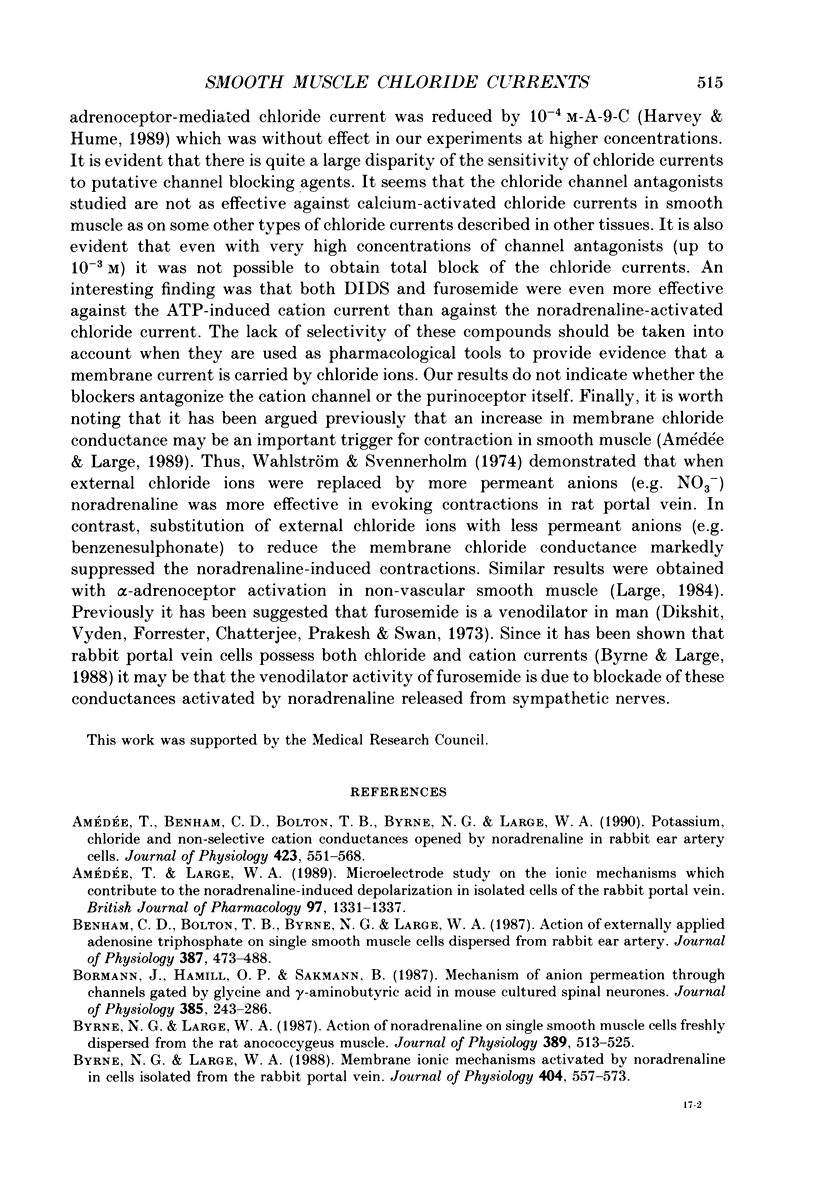Abstract
1. Responses to noradrenaline were studied in isolated rabbit ear artery cells with the nystatin method of whole-cell patch-clamp recording. With this technique it was possible to obtain reproducible responses to noradrenaline which was not possible with traditional whole-cell recording. 2. With NaCl as the major constituent of the bathing solution (potassium-free pipette and external solutions) the reversal potential (Er) of the noradrenaline-evoked current was about 0 mV. When external chloride was replaced by thiocyanate, iodide, nitrate and bromide, Er was shifted to more negative potentials which indicates that a chloride conductance increase contributes to the current activated by noradrenaline. 3. When sodium was substituted by Tris, N-methyl-D-glucamine, choline or barium, Er of the noradrenaline-evoked current did not alter. This result suggests that a cation conductance is not implicated in the response to noradrenaline recorded with the nystatin method of whole-cell recording. 4. The chloride current activated by noradrenaline was blocked by the selective alpha 1-adrenoceptor antagonist prazosin but was not affected by the alpha 2-adrenoceptor antagonist yohimbine. 5. When cells were exposed to zero calcium bathing solutions the amplitude of the current elicited by noradrenaline was unaffected when measured within 1-2 min in zero calcium conditions. Continued exposure to 0 Ca + 1 mM-EGTA solution reversibly abolished the chloride current to noradrenaline. 6. In the presence of caffeine, which releases Ca2+ from internal stores and itself induced an inward current (at a holding potential of -50 mV), noradrenaline did not elicit a current. These data suggest that the chloride current evoked by noradrenaline results from an increase in intracellular concentration of calcium derived from internal stores. 7. The chloride channel blocking agents 4,4'-diisothiocyanatostilbene-2,2'-disulphonic acid (DIDS; 0.5 mM) and furosemide (0.5 mM) produced partial reduction of the noradrenaline-evoked chloride current whereas 4-acetamido-4'-isothiocyanatostilbene-2,2'-disulphonic acid (SITS), anthracene-9-carboxylic acid (A-9-C) and picrotoxin were ineffective in concentrations of up to 0.5 mM. However DIDS and furosemide were non-selective blockers as both agents were more effective against the adenosine triphosphate-induced cation current.
Full text
PDF















Selected References
These references are in PubMed. This may not be the complete list of references from this article.
- Amédée T., Benham C. D., Bolton T. B., Byrne N. G., Large W. A. Potassium, chloride and non-selective cation conductances opened by noradrenaline in rabbit ear artery cells. J Physiol. 1990 Apr;423:551–568. doi: 10.1113/jphysiol.1990.sp018039. [DOI] [PMC free article] [PubMed] [Google Scholar]
- Amédée T., Large W. A. Microelectrode study on the ionic mechanisms which contribute to the noradrenaline-induced depolarization in isolated cells of the rabbit portal vein. Br J Pharmacol. 1989 Aug;97(4):1331–1337. doi: 10.1111/j.1476-5381.1989.tb12596.x. [DOI] [PMC free article] [PubMed] [Google Scholar]
- Benham C. D., Bolton T. B., Byrne N. G., Large W. A. Action of externally applied adenosine triphosphate on single smooth muscle cells dispersed from rabbit ear artery. J Physiol. 1987 Jun;387:473–488. doi: 10.1113/jphysiol.1987.sp016585. [DOI] [PMC free article] [PubMed] [Google Scholar]
- Bormann J., Hamill O. P., Sakmann B. Mechanism of anion permeation through channels gated by glycine and gamma-aminobutyric acid in mouse cultured spinal neurones. J Physiol. 1987 Apr;385:243–286. doi: 10.1113/jphysiol.1987.sp016493. [DOI] [PMC free article] [PubMed] [Google Scholar]
- Byrne N. G., Large W. A. Action of noradrenaline on single smooth muscle cells freshly dispersed from the rat anococcygeus muscle. J Physiol. 1987 Aug;389:513–525. doi: 10.1113/jphysiol.1987.sp016669. [DOI] [PMC free article] [PubMed] [Google Scholar]
- Byrne N. G., Large W. A. Membrane ionic mechanisms activated by noradrenaline in cells isolated from the rabbit portal vein. J Physiol. 1988 Oct;404:557–573. doi: 10.1113/jphysiol.1988.sp017306. [DOI] [PMC free article] [PubMed] [Google Scholar]
- Dikshit K., Vyden J. K., Forrester J. S., Chatterjee K., Prakash R., Swan H. J. Renal and extrarenal hemodynamic effects of furosemide in congestive heart failure after acute myocardial infarction. N Engl J Med. 1973 May 24;288(21):1087–1090. doi: 10.1056/NEJM197305242882102. [DOI] [PubMed] [Google Scholar]
- Evans M. G., Marty A. Calcium-dependent chloride currents in isolated cells from rat lacrimal glands. J Physiol. 1986 Sep;378:437–460. doi: 10.1113/jphysiol.1986.sp016229. [DOI] [PMC free article] [PubMed] [Google Scholar]
- Evans M. G., Marty A., Tan Y. P., Trautmann A. Blockage of Ca-activated Cl conductance by furosemide in rat lacrimal glands. Pflugers Arch. 1986 Jan;406(1):65–68. doi: 10.1007/BF00582955. [DOI] [PubMed] [Google Scholar]
- Gray P. T., Ritchie J. M. A voltage-gated chloride conductance in rat cultured astrocytes. Proc R Soc Lond B Biol Sci. 1986 Aug 22;228(1252):267–288. doi: 10.1098/rspb.1986.0055. [DOI] [PubMed] [Google Scholar]
- Harvey R. D., Hume J. R. Autonomic regulation of a chloride current in heart. Science. 1989 May 26;244(4907):983–985. doi: 10.1126/science.2543073. [DOI] [PubMed] [Google Scholar]
- Honoré E., Martin C., Mironneau C., Mironneau J. An ATP-sensitive conductance in cultured smooth muscle cells from pregnant rat myometrium. Am J Physiol. 1989 Aug;257(2 Pt 1):C297–C305. doi: 10.1152/ajpcell.1989.257.2.C297. [DOI] [PubMed] [Google Scholar]
- Horn R., Marty A. Muscarinic activation of ionic currents measured by a new whole-cell recording method. J Gen Physiol. 1988 Aug;92(2):145–159. doi: 10.1085/jgp.92.2.145. [DOI] [PMC free article] [PubMed] [Google Scholar]
- Large W. A. The effect of chloride removal on the responses of the isolated rat anococcygeus muscle to alpha 1-adrenoceptor stimulation. J Physiol. 1984 Jul;352:17–29. doi: 10.1113/jphysiol.1984.sp015275. [DOI] [PMC free article] [PubMed] [Google Scholar]
- Marty A., Tan Y. P., Trautmann A. Three types of calcium-dependent channel in rat lacrimal glands. J Physiol. 1984 Dec;357:293–325. doi: 10.1113/jphysiol.1984.sp015501. [DOI] [PMC free article] [PubMed] [Google Scholar]
- Pacaud P., Loirand G., Lavie J. L., Mironneau C., Mironneau J. Calcium-activated chloride current in rat vascular smooth muscle cells in short-term primary culture. Pflugers Arch. 1989 Apr;413(6):629–636. doi: 10.1007/BF00581813. [DOI] [PubMed] [Google Scholar]
- Suzuki H., Kou K. Electrical components contributing to the nerve-mediated contractions in the smooth muscles of the rabbit ear artery. Jpn J Physiol. 1983;33(5):743–756. doi: 10.2170/jjphysiol.33.743. [DOI] [PubMed] [Google Scholar]
- Wahlström B. A., Svennerholm B. Potentiation and inhibition of noradrenaline induced contractions of the rat portal vein in anion substituted solutions. Acta Physiol Scand. 1974 Nov;92(3):404–411. doi: 10.1111/j.1748-1716.1974.tb05758.x. [DOI] [PubMed] [Google Scholar]


